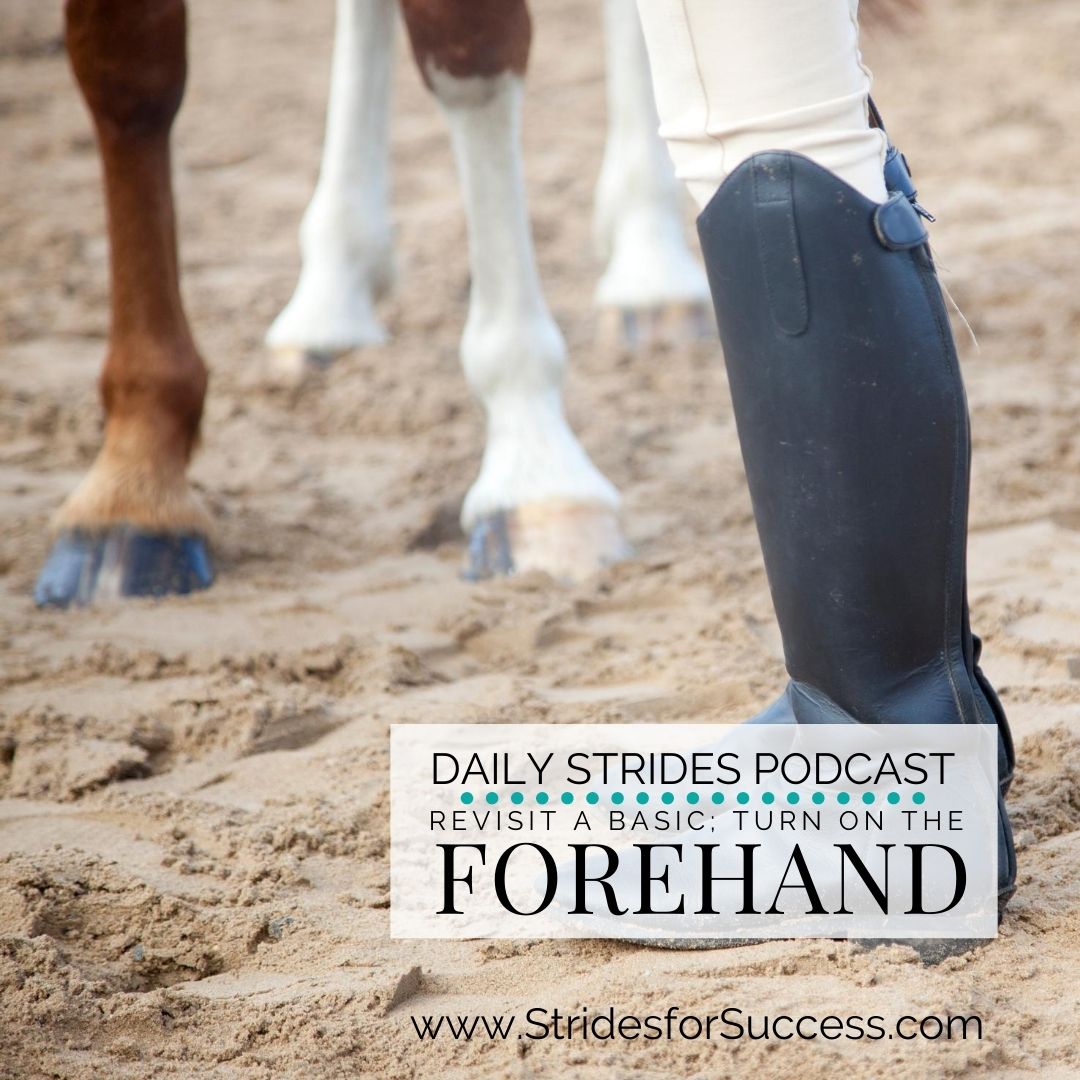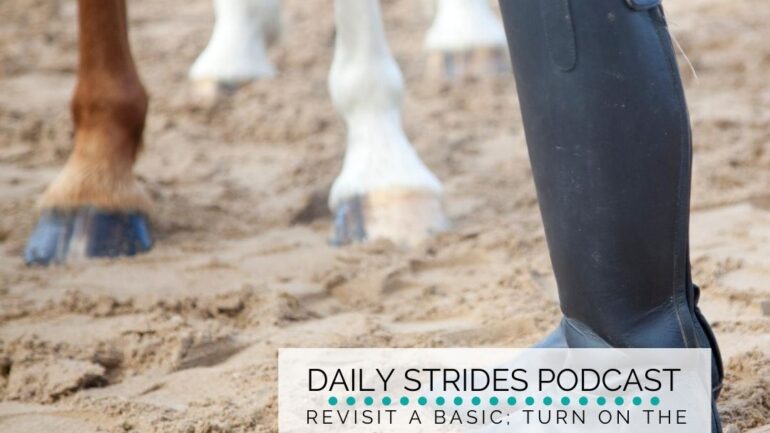Forward and sideways. And yet, without leaving the spot you’re in… It can feel so contradictory and, maybe even asking for the impossible! But no, It is all possible. And pretty simple to get started with. You’re simply beginning to really work on turn on the forehand with your horse. So many riders fail to include the ‘forward’ part of the equation when working on this basic movement.
And the power really does lie in the ‘forward’ aspect of this, especially when you take the time to revisit it from a more developed and more progressed place in your riding journey.
If you are at a loose end with your horse this week, I am going to suggest incorporating turn on the forehand into your training somewhere. Whether it is on the ground, in groundwork. Or on the trail at a gate or fence. Maybe you’ll go the traditional route and practice in the arena. Whatever you decide, this versatile movement can help you and your horse at all stages in your development and work together.

What is Turn on the Forehand?
Simply put, turn on the forehand is when your horse moves his back legs in an arc around his front legs, which remain stationary in one place. Obviously, in order to do this, your horse must turn his front feet as he is moving around so that his body remains aligned.
And alignment is one of the keys to a good quality turn on the forehand; the energy must remain inside of the container of horse and rider.
Imagine you are riding on the right rein around your arena. You halt on the track, by the rail; so your horse’s body is parallel to the rail or arena fence. Now, from this place, your horse will move his hindquarters to the right, towards the center of the arena. For the sake of this example, I want you to imagine that his hindquarters do a full semi-circle. A half-circle. This will mean that when he has finished he will, again, be parallel to the rail of your arena. But now you will be on the left rein, facing the opposite direction. And all without his front hooves moving too far from the original place they began from the initial halt.
I have another post all about the mechanics of turn on the forehand HERE
Thinking Forward ‘and’ Sideways
One of the confusing elements of a turn on the forehand for many riders is how to incorporate the forwards into the movement. Forwards while really not going anywhere can be a difficult concept for many riders. However, this is really what makes the turn on the forehand so valuable to have as a basic you revisit and improve over time.
Forwards begins in the heads of both horse and rider. Both must think forward first. Turn on the forehand, while not technically moving forward, requires forwardness in order to maintain rhythm.
As the horse moves through the turn on the forehand, he moves in the sequence of the walk. His feet should follow the same pattern of movement that would happen if he was walking forward. Left hind, left front, right hind, right front, left hind, left front, right hind, right front…
The goal is to maintain the sequence and rhythm of the walk. Except instead of moving forward, his back hooves move sideways. And his front lift up, rotate slightly and are put down as close a possible from where they lifted from.
This requires ‘forwardness’, even if you never technically leave the spot you are working from…
An Arc Inside of an Arc
So, with the end goal being the front feet remaining ‘stationary’ while the back end moves around them, this is definitely something to work towards in your riding. Initially, you will probably find that your horses front feet do move a little. They will form their own smaller arc inside of the bigger arc created by the back feet.
Part of the work of revisiting this basic movement in your training is to begin introducing the principle of collection to both yourself and your horse.
Yes, the basic turn on the forehand is one of the simplest ways you can begin introducing this concept to your horse. Collection is a big topic. There is a reason it is at the top of the traditional training scale; it requires a lot of development from both horse and rider in order to correctly achieve. And yet, when you think about turn on the forehand, the movement of the front legs, if done right, requires collection.
Collection is when the energy moves more ‘up’ than ‘out’. The front feet in a correctly performed turn on the forehand do just this; up not out.
So look for an arc within the arc initially. However, as you revisit this movement again and again over the coming months and years, begin thinking about collection. Forwardness while staying in the same place. The up rather than the out.
You Ask Your Horse To Move
Another great benefit to incorporating turn on the forehand into your regular revisiting of the basics is that you fine-tune your ‘asking’ skills. So many riders try to move their horse using their aids. It is exhausting and distracting to both horse and rider.
Your aids were never created to move an animal that outweighs you 10 to 1. Your aids simply ask your horse to move. You ask. He moves.
And yet, riders want to literally shove their horse across the arena. Turn on the forehand really gets you thinking about the true work of your aids. To clearly communicate what it is that you want your horse to do.
As a rider, you can only ever hope to better influence your horse. You cannot and should not try to physically move your horse!
The Concept of Inside and Outside
The final reason I love turn on the forehand is that it gets riders thinking differently. For most riders, up to the point where turn on the forehand is introduced, inside and outside is dictated by the horse’s position in the arena. The side closest to the railing is the outside. And the side closest to the center of the arena is the inside.
Turn on the forehand requires the rider to think in terms of the flexion in order to identify inside and outside
And this thinking about flexion and bend is the basis for clearer communication regarding suppleness, aids, channel, contact and so much more for the rider. It forces a new perspective in order to achieve a simple result. Over.
Revisiting This Basic Regularly
I am a big believer in the basics. They are the foundation for all the fancy and complicated ‘stuff’ that riders want to achieve later in their riding. However, they must be revisited from each new level you reach as a rider. From each new perspective.
I am going to suggest getting turn on the forehand into your training with your horse on a regular basis. And doing so from the new perspective each time.
Turn on the forehand can seem basic. It can seem like a means to an end. The end being more complicated and fancy lateral movements. however, this humble movement is important in its own right. And it is often simple enough to give you and your horse a quick win while moving the whole conversation forward.
Happy Riding
Lorna
Additional Resources on This Topic:-
-
-
- Turn on the Forehand – How to Ride a Balanced One
- Plan 1 Month of Riding in 1 Hour Live Workshop
- Out Of Planning and Into Action
- Having Realistic Expectations for Your Riding
- FREE Weeks Riding Plan
- Online community for equestrians working on their mindset & fitness
- Online Community for equestrians focusing on re-schooling horses (and ex-racehorses)
-

